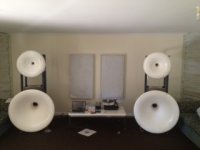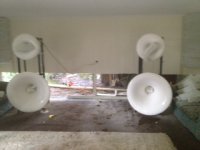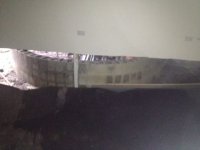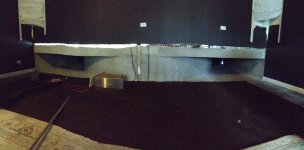I would use 400hz tractrix from 1khz. especially if your 6681's have phenolic diaphragms. Even with aluminium diaphragms 200hz horn is too large and will negatively affect 6681 high frequencies.
Hello,
real mesurements on a 160Hz Le CLéac'h horn don't show what you said:
http://www.azurahorn.com/6681_on_160.pdf
Best regards from Paris
Jean-Michel Le Cléac'h
Jean-Michel
What are your thought on using the Fane 8m in a 110hz Tractrix then the LeCleac'h flare for the 6681 driver?
Regards
What are your thought on using the Fane 8m in a 110hz Tractrix then the LeCleac'h flare for the 6681 driver?
Regards
Hello,
The Yamaha was not professionally used below 400Hz (or so) but for hifi purposes it can go down very low in frequency. The Yamaha is one of those rarest drivers to be able to reproduce the full low-mid frequency range. So you don't need the Fane 8m.
I prefer to recommand to modify a JMLC200T for the Yamaha JA6681 and to use a high-pass crossover above 300Hz (but depending on your sensitivity to phase distortion you may even use a lower cut-off frequency.) Also a very simple equalizer can be made in order to linearize the response above 6k...
Then the next step is to build a stand bass horn...
This will be the ideal 2 ways hig_end system an audiophile can dream of...
Best regards from Paris,
Jean-Michel Le Cléac'h
The Yamaha was not professionally used below 400Hz (or so) but for hifi purposes it can go down very low in frequency. The Yamaha is one of those rarest drivers to be able to reproduce the full low-mid frequency range. So you don't need the Fane 8m.
I prefer to recommand to modify a JMLC200T for the Yamaha JA6681 and to use a high-pass crossover above 300Hz (but depending on your sensitivity to phase distortion you may even use a lower cut-off frequency.) Also a very simple equalizer can be made in order to linearize the response above 6k...
Then the next step is to build a stand bass horn...
This will be the ideal 2 ways hig_end system an audiophile can dream of...
Best regards from Paris,
Jean-Michel Le Cléac'h
Sadly I am in the process of selling my home, but when looking for a new home there will be 2 features, a big shed and a large music room.
I am thinking of large bass horns, possible the stand type but split down the middle and stacked vertically on the side walls, beside the main speakers. They would integrate well and construction would be relatively simple.
I am thinking of large bass horns, possible the stand type but split down the middle and stacked vertically on the side walls, beside the main speakers. They would integrate well and construction would be relatively simple.
…….and here it is. Beginning to take shape
First picture is before the bass horn construction.
First picture is before the bass horn construction.
Attachments
Last edited:
JA6681b on eBay
Bought a pair of these rare Yam. 6681b drivers from this seller. Very good communication. Can't vouch for condition as they have not arrived yet. He was willing to take a pic of the cantilever suspension for rough inspection and personally checked the set he sent me. He has four drivers left. I have no personal affiliation with this seller.
eBay ID: Beeg456
Regards to all.
Jason
Bought a pair of these rare Yam. 6681b drivers from this seller. Very good communication. Can't vouch for condition as they have not arrived yet. He was willing to take a pic of the cantilever suspension for rough inspection and personally checked the set he sent me. He has four drivers left. I have no personal affiliation with this seller.
eBay ID: Beeg456
Regards to all.
Jason
I intended to update sooner however I got busy. The drivers arrived and appear to work well. I have yet to inspect the diaphragms but no obvious signs of distortion. More drivers are available from the same seller on ebay. I tried these crossed very high 1khz. and ran them to their natural top roll-off around 10khz. Sounded very flat and detailed. great imaging. Is there a particular horn profile that would be appropriate for this range? I use a Super tweeter above 10k. It may seem naive but at this range would a simple wave guide be just as effective? Thanks in advance.
Jason
NYC
Jason
NYC
Jason,
One of the best profiles is the one being discussed in this thread! 😀
A bit depends on how low you will run, your room size and a few other factors.
There are a wide variety of profiles that range from conical, through classic exponential (including multicells), tractrix, the Jmmlc and other variations (Iwata), and the Geddes type "waveguide" which is related to the Peavey horns (oblate spheroid). Each has pros and cons as well as advocates.
Fwiw you can get very good results from a 300Hz Altec/WE (or other) multicell. But they are imperfect, as are *all* horns and drivers. It depends on how much compromise and in which areas are acceptable to you.
There are a ton of threads on these horn profiles, including build info, here on DIY and related web pages.
It's a very deep subject.
A key point is where you will set your LF limit for the given driver/horn and why. This will dictate some aspects of the system and horn.
The drivers you have are capable of going a bit lower than most, in home use, so you may or may not wish to utilize this capability...
_-_-
One of the best profiles is the one being discussed in this thread! 😀
A bit depends on how low you will run, your room size and a few other factors.
There are a wide variety of profiles that range from conical, through classic exponential (including multicells), tractrix, the Jmmlc and other variations (Iwata), and the Geddes type "waveguide" which is related to the Peavey horns (oblate spheroid). Each has pros and cons as well as advocates.
Fwiw you can get very good results from a 300Hz Altec/WE (or other) multicell. But they are imperfect, as are *all* horns and drivers. It depends on how much compromise and in which areas are acceptable to you.
There are a ton of threads on these horn profiles, including build info, here on DIY and related web pages.
It's a very deep subject.
A key point is where you will set your LF limit for the given driver/horn and why. This will dictate some aspects of the system and horn.
The drivers you have are capable of going a bit lower than most, in home use, so you may or may not wish to utilize this capability...
_-_-
Pooh and Bear (any connection?) thank you for your input. I love the aesthetics of the JMLC horns. As I am covering the lion's share of the spectrum with a 12" cone driver, the horn or wave guide would only be used for purposes of dispersion. This is an uneducated and unsubstantiated opinion, however. I listen " near field" so spl is not an isse either.
The efficiency of these horns is startling. I will research the profiles you both mentioned.
Regards,
Jason
The efficiency of these horns is startling. I will research the profiles you both mentioned.
Regards,
Jason
Hello,
For the bass the best solution is a bass "stand" bass horn as in those pictures
http://www.diyaudio.com/forums/atta...427-jean-michel-lecleach-horns-floor-horn.jpg
and:
http://img209.imageshack.us/img209/7042/estrade31024x768qs8.jpg
Both have been caculated using one of the spreadsheets I designed in order to calculate "quasi cylindrical waves horn".
For what I know there is around half a dozen bass horns of this type having been built here in France. They sound great. This is the best bass sound reproduced by a loudspeaker that I could heard.
See a top view schematics in attached file.
As my listening room here in Paris is quite small I plan to use a corner stand bass horn. See the red contour in the top view schematics (second attached file).
Best regards from Paris, France
Jean-Michel Le Cléac'h
Does any one know how high up in frequency such an off-axis stand horn can be utilised? Can it be brought as far up as 4-500 hz, so it can be mated with e.g. a JMLC 200t?
Best regards
Gisle
Does any one know how high up in frequency such an off-axis stand horn can be utilised? Can it be brought as far up as 4-500 hz, so it can be mated with e.g. a JMLC 200t?
Best regards
Gisle
With the right driver it should go that high. The picture shows a large front loaded horn without folds. It should go up that high well with the right driver.
Thanks Pooh
Do you (or anyone else) how the stand horn is calculated? Is it to just calculate a normal jmlc profile, except for rollback, and then let the side of the horn which is not parallell to the sidewall expand double, so the sum of the expantion equals the horn as a two-flared horn? I guess that would produce a similar pressure/loading in the two different horn contours but I am not certain what this will do with the directivity.
Best regards Gisle
Do you (or anyone else) how the stand horn is calculated? Is it to just calculate a normal jmlc profile, except for rollback, and then let the side of the horn which is not parallell to the sidewall expand double, so the sum of the expantion equals the horn as a two-flared horn? I guess that would produce a similar pressure/loading in the two different horn contours but I am not certain what this will do with the directivity.
Best regards Gisle
Jean-Michel has a spreadsheet for calculating his quasi-cylindrical horns which you should find in his main thread.
Last link in post 783 provides the link Audiodidkt.
http://www.diyaudio.com/forums/multi-way/140190-jean-michel-lecleach-horns-79.html
http://www.diyaudio.com/forums/multi-way/140190-jean-michel-lecleach-horns-79.html
Good finding the post, 3G.
[ There's a thread in forum problems on links not working depending on our personal 'posts per page' setting (I use 50), so here's my version of the link extracted from the post number in case it helps ]
[ There's a thread in forum problems on links not working depending on our personal 'posts per page' setting (I use 50), so here's my version of the link extracted from the post number in case it helps ]
I also have a Radian 475bebp which I plan to mate with a jmlc 800-horn. The Radian has an exit angle of 6 degrees. Do anyone know what would be the ideal T to match the exit angle?
Best regards
Gisle Danielssen
(I do not have hornresp as I only have access to a Mac)
Edit: I might just use the spread sheet an adjust T untill the first cm has an angle of 6 degrees?
Best regards
Gisle Danielssen
(I do not have hornresp as I only have access to a Mac)
Edit: I might just use the spread sheet an adjust T untill the first cm has an angle of 6 degrees?
Last edited:
- Status
- Not open for further replies.
- Home
- Loudspeakers
- Multi-Way
- My Le Cleac'h horn build



